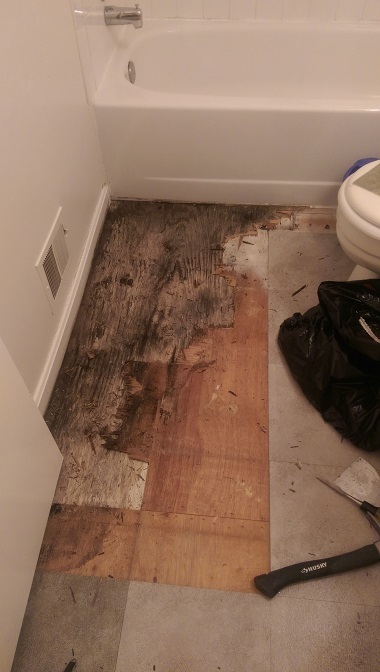They are making a few great annotation relating to How to Repair and Prevent Bathroom Water Damage in general in the article directly below.

The restroom is incredibly susceptible for damp build-up as well as prospective water damage because of the regular use of water in it. This short article provides straightforward examination strategies to assist spotting water damage risks.
The frequent use water in the shower room makes it very susceptible for moist buildup as well as possible water damage. By inspecting it frequently, you can lower water related problems.
The following collection of inspections is simple to carry out and also ought to be done as soon as in every 3 months in order to keep your washroom in good shape and also to avoid potential water problems caused by the tub, the shower, pipe joints and also plumbing, sinks, cabinets, and also the commode
Do not overlook carrying out these inspections and also be complete while doing them. Keep in mind that these straightforward assessments can save you a lot of cash by offering early signs for water damage
Bath tub as well as Shower
The shower and bath tub need special focus as well as maintenance. Examine the ceramic tiles and also change if broken. Make certain that there is no missing cement between the ceramic tiles. Inspect as well as replace broken caulking at joints where the wall surfaces satisfy the flooring or the bathtub. Obstructed drains as well as pipelines problems will stop the bath tub from drying as well as might indicate major troubles under the bathtub. Talk to a specialist promptly to stop structural damages. Pay attention to discolorations or soft locations around the bathtub walls as they might indicate an interior leakage.
Plumbing
Signs for water damage are hard to discover considering that the majority of pipes are installed inside the walls.
Pay unique focus to floor covering and walls moisture and also stains as they may suggest an unseen plumbing trouble. Check moisture levels in adjoining spaces also.
Sinks as well as Cabinets
Sinks and also closets are revealed to dampness and moisture daily as well as are commonly forgotten. Inspect routinely under the sink and on the counter top over it. Fix any kind of drip in the catch as it may suggest drain issues. Browse the sink, slow-moving draining pipelines might indicate a blocked drain. Replace sink seals if they are broken or loose.
The Bathroom
The bathroom is a prone water joint. Inspect the water lines and also look for leakages around the commode seat, in the tube, and also under the water container. If you detect any signs of moisture on the floor around the toilet, check for leaks in the toilet rim and tank seals.
Know that hanging bathroom dish deodorants boosts the possibilities for blockages.
Water Damage Signs In The Bathroom To Avoid Cleanup
Musty smell
This is one of the easiest signs to catch because musty smells are so odorous. The damp, earthy, moldy smell should be a big red flag. The smell will develop when moisture gets trapped in surfaces, and begins to facilitate mold growth. Leaking pipes under cabinets, inside walls, and behind shower fixtures will cause moisture to stay trapped and not dry, which will lead to mold growth and spread. As soon as you notice any musty smells in your bathroom, have it checked for hidden water damage and cleanup signs.
Visible mold
If the smell isn’t there to give it away, sometimes you will actually see mold growth. Finding mold in your bathroom is a serious problem, because mold is very harmful to your health. By the time mold growth is visible, it also means that water damage has already occurred and been present for some time. The only way the mold problem can be resolved is to find the source of the moisture and get it stopped. To safely and adequately remove mold, you need to have professionals handle the remediation. Do not waste any time in getting mold problems addressed, fixed, and sanitized so that you can protect you and your family from the many respiratory symptoms caused by mold exposure.
Damaged floors
Bathroom floors should be able to withstand some exposure to water while still remaining in good condition. However, when excess exposure or water leaks occur, they will begin to damage even the most water-resistant flooring. If you notice any cracking, bubbling, staining, or warping on your bathroom floors, there is probably a water leak somewhere causing the distortion. If you notice areas of the floor have become softer, or even have a spongy feeling, there is probably damage to the subfloor. Subflooring is typically made up of plywood. When plywood is exposed to water or moisture, it will absorb it. Once it has become saturated, the weight of the excess water will cause the wood to swell and soften. Check the floors in your bathroom frequently to catch any of these sings before they lead to damaged subflooring.
Changes on walls
When water leaks behind walls, it will cause changes in the drywall. Peeling plaster, blistering paint, and soggy wallpaper are all good indicators that excess water is building up behind the wall. Water leaking behind drywall will cause it to swell and be soft to the tough. If you start to notice gaps along the trim of your walls, or where tile meets the wall, it could also be a strong indicator that there is a leak behind the wall. Any changes, distortion, or damage on the walls should be evaluated as soon as you notice it to prevent further water damage and cleanup.

I'm just very interested in Looking for Signs of Water Damage in the Bathroom and I hope you enjoyed our post. Enjoyed our content? Please share it. Let another person discover it. Thanks so much for taking the time to read it.
Check Us Out